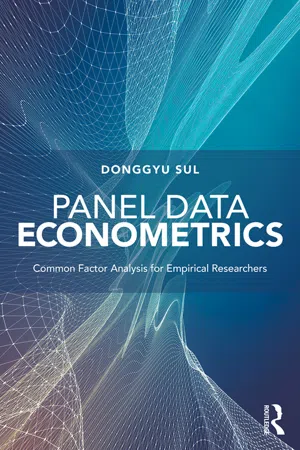![]()
1
Basic Structure of Panel Data
This chapter is the most basic and important chapter in this book. I encourage readers to digest this first chapter carefully. This chapter provides the basic structure of a panel data, which can be decomposed into time invariant individual specific variables, time-varying common variables, and time-varying individual specific variables. We will study how to identify each component statistically. By doing so, we will learn the economic meaning of each component.
Let yit be a data of interest for the i−th individual (or firm, region, group, country) at time t.1 The i−th unit is called the cross-sectional unit. The total number of the cross-sectional unit is denoted as n. That is, i = 1, …, n. The range of the time index is denoted as t = 1, …, T. The variable y must have the same attributes across i over t. For example, a panel of household income includes only income data for each household during a certain time period.
In the end, we will consider the following general structure of a panel data.
| (1.1) |
 | (1.1) |
where ai is a time invariant term, bit is a time-varying individual growth rate, λit is a vector of time-varying factor loading coefficients, θt is a vector of common factors, and is a leftover term or purely idiosyncractic term. However, we start from a basic and simple model by assuming that bit = 0 for all i and t, and λit = 1 for all i and t. These assumptions lead to
 | (1.2) |
Later we will relax these strong assumptions one by one.
1.1 Meaning of fixed effect
In this section, we study the economic meaning of the time invariant terms – ai (individual mean) and bi (slope coefficient on the trend term). First, we consider the economic meaning of ai with non-trended data.
1.1.1 Fixed effects with non-trended data
We rewrite (1.2) as
where ai is a time invariant unobserved variable, and is a time-varying variable with a mean of zero and finite variance. In this section, the parameter of interest is ai, which is often called “fixed effect” among applied ecometricians.2 Nonetheless, this unobserved time invariant variable can be identified and estimated if the number of time series...


